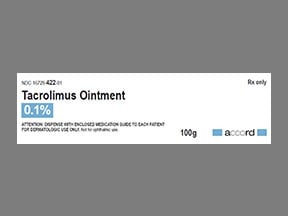
Protopic Coupons & Savings Card – Discount Prices from $74.60
Brand for: Tacrolimus
My prescription
Edit
100GM of 0.1%, Tacrolimus (1 Tube)
Select pharmacy

CVS
$74.60
COUPON PRICE
Walgreens
$110.30
COUPON PRICE
Albertsons
$152.70
COUPON PRICE
Walmart
$218.27
COUPON PRICEProtopic savings card
Show this card to your pharmacist
CVS
$74.60
BIN
ID
PCN
GRP
019876
LHEAC3E02D
CHIPPO
LHX
Powered by
Related CNI immunosuppressants prescriptions
More prescriptions for organ transplant
Related CNI immunosuppressants prescriptions
More prescriptions for organ transplant
Price history for Protopic (brand) & Tacrolimus (generic)
1 Tube, 100GM of 0.1%
Average retail price for Protopic
Average retail price for Tacrolimus
Average SaveHealth price for Tacrolimus
Our price history data is based on aggregated prescription data collected from participating pharmacies in America. Our prescription data updates daily to reflect the latest price changes. If you notice a missing data point, it means there wasn't sufficient data available to generate a monetary value for that date.
Over the last 12 months, the average discount price of Protopic is $130.43 using the SaveHealth savings card. That's an average savings of 88.66% on Protopic with our discount card.
*Retail prices are based on pharmacy claims data, and may not be accurate when we don't have enough claims.
Protopic (Tacrolimus) dosage forms
Dosage Quantity Price from Per unit 100GM of 0.1% 1 Tube $74.60 $74.60 100GM of 0.1% 2 Tubes $123.20 $61.60 100GM of 0.1% 3 Tubes $171.80 $57.27 100GM of 0.03% 1 Tube $74.60 $74.60 100GM of 0.03% 2 Tubes $123.20 $61.60 100GM of 0.03% 3 Tubes $171.80 $57.27
| Dosage | Quantity | Price from | Per unit |
|---|---|---|---|
| 100GM of 0.1% | 1 Tube | $74.60 | $74.60 |
| 100GM of 0.1% | 2 Tubes | $123.20 | $61.60 |
| 100GM of 0.1% | 3 Tubes | $171.80 | $57.27 |
| 100GM of 0.03% | 1 Tube | $74.60 | $74.60 |
| 100GM of 0.03% | 2 Tubes | $123.20 | $61.60 |
| 100GM of 0.03% | 3 Tubes | $171.80 | $57.27 |
Protopic Warnings
Tacrolimus is a medication that has shown benefits when used appropriately, though its long-term safety remains under study. There have been rare instances of cancers, such as skin cancer and lymphoma, reported in individuals using tacrolimus on the skin, though a direct link has not been established. Below are important safety considerations and warnings to keep in mind:
Cancer Risk: Some users of tacrolimus have reported rare cases of skin and lymphoma cancer. It is crucial to apply the ointment strictly as prescribed, avoiding use on unaffected areas and limiting the duration of treatment. If symptoms persist beyond six weeks, consult with your healthcare provider for a reassessment.
Immune System Impact: Prolonged use of tacrolimus may weaken the immune system. Monitor for signs of infection and inform your healthcare provider if you experience any.
Infection Risk: Tacrolimus may increase the risk of developing infections like chickenpox, shingles, and other herpes infections. Avoid applying the medication to infected areas. If an infection develops, discontinue use and contact your healthcare provider for further guidance.
Swollen Lymph Nodes: Report any swollen lymph nodes to your healthcare provider, as this might indicate an infection or a more serious condition requiring discontinuation of the medication.
Sun Exposure: Tacrolimus can affect your skin's response to sunlight, increasing the risk of sunburn. Use sunscreen, wear protective clothing, and avoid tanning beds and direct sunlight during treatment.
Renal Concerns: In rare cases, tacrolimus has been associated with sudden kidney failure, especially when applied over large skin areas with compromised skin barriers. Discuss any concerns with your healthcare provider.
Usage Guidelines: This drug should be reserved for situations where other treatments have failed or are not suitable. Use the smallest effective amount and restrict its use to affected skin only. Tacrolimus is not recommended for children under 2 years of age.
Always discuss the potential risks and benefits of tacrolimus with your healthcare provider to ensure its safe and effective use. In the event of unusual symptoms such as lumps, swollen glands, or growths, seek medical advice promptly.
Protopic Side Effects
When using this medication, some individuals may experience mild side effects such as burning, itching, or soreness of the skin, particularly in the initial days of treatment. These sensations are generally temporary. Flu-like symptoms, which may include fever, chills, runny nose, and muscle aches, can also occur. Other common side effects include headaches and increased sensitivity to temperature changes or touch. Most people find these symptoms manageable and they often resolve on their own. However, if they persist or become bothersome, it's advisable to consult with a healthcare provider. There are more serious side effects that are rare but require immediate attention if they occur. These include severe fatigue, muscle or joint pain, skin infections or sores like chicken pox or shingles, unusual chest pain, or any appearance of tumors or warts. It is essential to seek urgent medical care if you experience any of these symptoms. Additionally, though a very serious allergic reaction is rare, be vigilant for signs such as rash, severe dizziness, or difficulty breathing, and seek medical help immediately if they occur. This list does not cover all possible side effects, so you should reach out to a healthcare provider if you notice any other concerning symptoms.
Protopic Interactions
Protopic (tacrolimus) is a topical medication used to treat certain skin conditions. While it is applied to the skin, a small amount can be absorbed into the bloodstream, which may lead to interactions with other substances.
Alcohol: Consuming alcohol while using Protopic may cause your skin or face to become flushed, red, and feel warm. This reaction typically occurs within 5 to 15 minutes after drinking alcohol and can last for about an hour. It's advisable to limit or avoid alcohol consumption during treatment.
Medications: Certain medications can affect how Protopic works or increase the risk of side effects. These include:
Antifungal medications: Drugs like Ketoconazole, Fluconazole, and Itraconazole may increase the amount of tacrolimus in your blood.
Antibiotics: Medications such as Erythromycin and Clarithromycin can also raise tacrolimus levels.
Calcium channel blockers: Used to treat high blood pressure, medications like diltiazem, Verapamil, and Amlodipine may interact with Protopic.
Cimetidine: A medication for heartburn and stomach ulcers, cimetidine can affect tacrolimus levels.
If you are taking any of these medications, inform your healthcare provider. They may need to monitor your treatment more closely or adjust your medication regimen.
Other Topical Products: Using other skin products alongside Protopic, especially those containing alcohol or other active ingredients, may increase the risk of skin irritation. It's best to consult your healthcare provider before combining Protopic with other topical treatments.
Vaccinations: Protopic may affect your immune system. Before receiving any vaccines, inform your healthcare provider that you are using Protopic, as it may influence the effectiveness of certain immunizations.
Always provide your healthcare provider with a complete list of all medications, supplements, and herbal products you are using to ensure safe and effective treatment.
What is PROTOPIC Ointment used for?
Protopic Ointment is used to treat moderate to severe atopic dermatitis (eczema) in patients who have not responded adequately to other treatments. It helps reduce inflammation and itching associated with eczema.
Is Protopic the same as hydrocortisone?
Protopic and hydrocortisone are not the same. Protopic contains tacrolimus, which is a calcineurin inhibitor, while hydrocortisone is a corticosteroid. They are used to treat different conditions and have different mechanisms of action.
What does Protopic do to your skin?
Protopic, which contains the active ingredient tacrolimus, is an immunosuppressant used topically to treat eczema (atopic dermatitis). It works by modulating the immune response in the skin, reducing inflammation, redness, and itching associated with eczema flare-ups. It is typically prescribed when other treatments have not been effective.
What is the difference between Protopic and hydrocortisone?
Protopic (tacrolimus) and hydrocortisone are both used to treat skin conditions, but they belong to different classes of medications and work in different ways. Protopic is a topical calcineurin inhibitor that suppresses the immune system to reduce inflammation and is often used for conditions like eczema, especially when other treatments are not suitable. Hydrocortisone, on the other hand, is a topical corticosteroid that reduces inflammation by mimicking the effects of hormones produced by the adrenal glands. It is commonly used for a variety of inflammatory skin conditions. Additionally, Protopic does not cause skin thinning, a potential side effect of prolonged use of topical corticosteroids like hydrocortisone.
Is Protopic safer than steroids?
Protopic (tacrolimus) and topical steroids are both used to treat skin conditions like eczema, but they have different safety profiles. Protopic does not cause skin thinning, a common side effect of long-term steroid use. However, Protopic may cause burning or itching at the application site and has a black box warning due to a potential risk of cancer. The safety of each depends on the individual's condition and medical history, so it is important to consult a healthcare provider to determine the most appropriate treatment.
